
The Padma Vibhushan is the second-highest civilian award of the Republic of India, after the Bharat Ratna. Instituted on 2 January 1954, the award is given for "exceptional and distinguished service". All persons without distinction of race, occupation, position or sex are eligible for these awards. However, government servants including those working with public sector undertakings, except doctors and scientists, are not eligible for these Awards. As of 2024, the award has been bestowed on 336 individuals, including thirty-one posthumous and twenty-one non-citizen recipients.
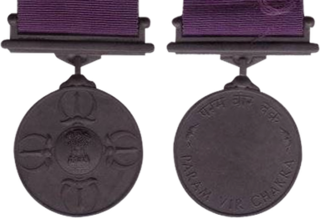
The Param Vir Chakra (PVC) is India's highest military decoration, awarded for displaying distinguished acts of valour during wartime. Param Vir Chakra translates as the "Wheel of the Ultimate Brave", and the award is granted for "most conspicuous bravery in the presence of the enemy". As of January 2018, the medal has been awarded 21 times, of which 14 were posthumous and 16 arose from actions in Indo-Pakistani conflicts. Of the 21 awardees, 20 have been from the Indian Army and one has been from the Indian Air Force. Major Somnath Sharma was the first recipient. A number of state governments of India as well as ministries of the central government provide allowances and rewards to recipients of the PVC.

The King's Police Medal (KPM) is awarded to police in the United Kingdom for gallantry or distinguished service. It was also formerly awarded within the wider British Empire, including Commonwealth countries, most of which now have their own honours systems. The medal was established on 7 July 1909, initially inspired by the need to recognise the gallantry of the police officers involved in the Tottenham Outrage. Renamed the King's Police and Fire Services Medal (KPFSM) in 1940, it was replaced on 19 May 1954 by the Queen's Police Medal (QPM), when a separate Queen's Fire Service Medal was also instituted. The current award was renamed the King's Police Medal following the death of Queen Elizabeth II in 2022 and the accession of King Charles III to the throne of the United Kingdom.
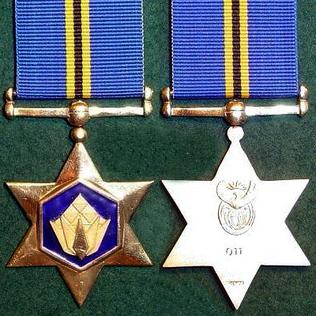
The iPhrothiya yeGolide - Golden Protea, post-nominal letters PG, was instituted by the President of the Republic of South Africa on 16 April 2003 and came into effect on 27 April 2003. It can be awarded to all ranks who have distinguished themselves by exceptional leadership or exceptional meritorious service and the utmost devotion to duty. It is South Africa's highest existing military decoration for meritorious conduct.
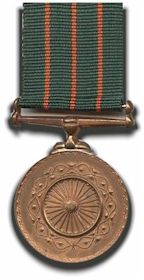
The Shaurya Chakra is an Indian military decoration awarded for valour, courageous action or self-sacrifice while not engaged in direct action with the enemy. It may be awarded to civilians as well as military personnel, sometimes posthumously. It is third in order of precedence of peacetime gallantry awards and comes after the Ashoka Chakra and the Kirti Chakra. It precedes the Yudh Seva Medal.

The Kirti Chakra is an Indian military decoration awarded for valour, courageous action or self-sacrifice away from the field of battle. It may be awarded to civilians as well as military personnel, including posthumous awards. It is the peacetime equivalent of the Maha Vir Chakra. It is second in order of precedence of peacetime gallantry awards, comes after Ashoka Chakra and before Shaurya Chakra. Before 1967, the award was known as the Ashoka Chakra, Class II.

The Sena Medal is awarded to members of the Indian army, of all ranks, "for such individual acts of exceptional devotion to duty or courage as have special significance for the Army." Awards may be made posthumously and a bar is authorized for subsequent awards of the Sena Medal.

The Yudh Seva Medal is one of India's military decorations for distinguished service during wartime. It is awarded for a high degree of distinguished service in an operational context, which includes times of war, conflict, or hostilities and may be awarded posthumously.

The Vayu Sena Medal is a military decoration, usually awarded in peacetime for a job well done in the Indian Air Force. However, it has been granted during times of conflict for acts of gallantry in the face of enemy, though not in the same numbers as the Vir Chakra.
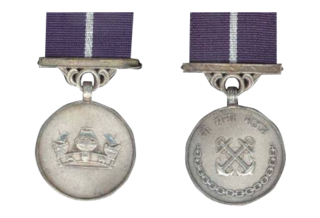
Nau Sena Medal is a gallantry award for servicemen in the Indian Navy.
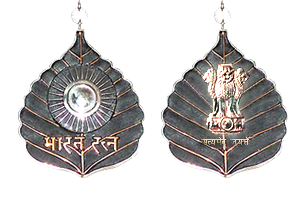
The Indian honours system is the system of awards given to individuals for a variety of services to the Republic of India. The categories of awards are as follows:

Param Vishisht Seva Medal (PVSM) is a military award of India. It is the highest peacetime medal of the Indian Armed Forces, and is awarded for "distinguished service of the most exceptional order." The medal is awarded for "distinguished service rendered by personnel of the Armed Forces." All ranks of the Armed Forces, including Territorial Army, Auxiliary and Reserve forces, Nursing officers and other members of the Nursing services and other lawfully constituted Armed Forces are eligible for the medal, which may be awarded multiple times as well as posthumously.

The Sarvottam Yudh Seva Medal is India's highest wartime distinguished service decoration. It is awarded for the highest degree of distinguished service in an operational context, which includes times of war, conflict, or hostilities. The award is a war-time equivalent of the Param Vishisht Seva Medal, which is India's highest peacetime distinguished service decoration.
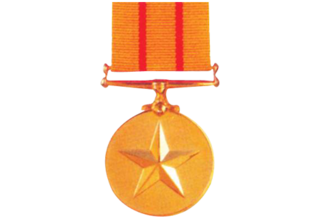
Uttam Yudh Seva Medal is one of India's military decorations for Wartime Distinguished Service. It is awarded for a high degree of distinguished services in an operational context. "Operational context" includes times of war, conflict, or hostilities. The award is a wartime equivalent of Ati Vishisht Seva Medal, which is a Peacetime Distinguished Service decoration. Uttam Yudh Seva Medal may be awarded posthumously.
V. S. R. Murthy, PTM, TM (Gallantry) is a retired Additional Director General of Indian Coast Guard.
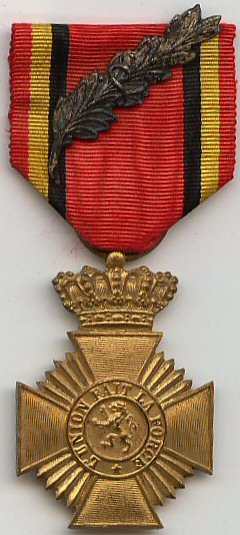
The Military Decoration for Exceptional Service or Acts of Courage or Devotion is awarded to personnel of the Belgian Armed Forces for either displayed herorism or for display of extraordinary devotion to duty. In history, sometimes it is referred to as an 'Article 4' award, as originally, the medal was created as a variation of the military decoration for long service. However, nowadays, both medals are distinct awards, albeit still having the same guilt cross.
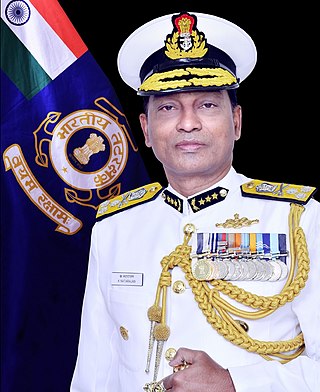
Krishnaswamy Natarajan PVSM, PTM, TM, is a retired Indian Coast Guard officer who served as the 23rd Director General of the Indian Coast Guard. He assumed the office on 1 July 2019 and served until his superannuation on 31 December 2021. He is currently the Executive Director of Regional Cooperation Agreement on Combating Piracy and Armed Robbery against ships in Asia - Information Sharing Centre in Singapore.
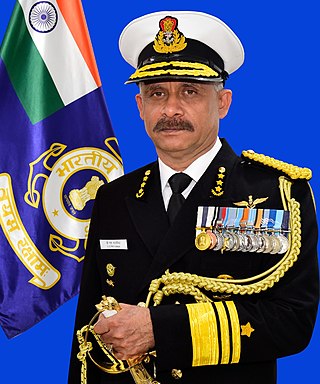
Virender Singh Pathania, PVSM, PTM, TM, is a retired Indian Coast Guard officer. He served as the 24th Director General of the Indian Coast Guard. He assumed the office on 31 December 2021 upon superannuation of Director General Krishnaswamy Natarajan. He is the first helicopter pilot to hold this position. Previously he served as Additional Director General of Indian Coast Guard and Coast Guard Commander of Western Seaboard.

The Tatrakshak Medal or Coast Guard Medal is an Indian military decoration, awarded for conspicuous devotion to duty or courage in Indian Coast Guard. It is conferred by the President of India every year on the occasion of national celebrations - the Independence Day and the Republic Day.

Rakesh Pal, AVSM, PTM, TM was a flag officer of the Indian Coast Guard. He served as the 25th Director General of the Indian Coast Guard.



















